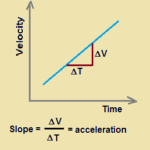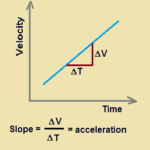As discussed in a previous part of Lesson 4, the shape of a velocity vs. time graph reveals pertinent information about an object’s acceleration. For example, if the acceleration is zero, then the velocity-time graph is a horizontal line – having a slope of zero. If the acceleration is positive, then the line is an upward sloping line – having a positive slope. If the acceleration is negative, then the velocity-time graph is a downward sloping line – having a negative slope. If the acceleration is great, then the line slopes up steeply – having a large slope. The shape of the line on the graph (horizontal, sloped, steeply sloped, mildly sloped, etc.) is descriptive of the object’s motion. This principle can be extended to any motion conceivable. In this part of the lesson, we will examine how the principle applies to a variety of types of motion. In each diagram below, a short verbal description of a motion is given (e.g., “constant, rightward velocity”) and an accompanying motion diagram is shown. Finally, the corresponding velocity-time graph is sketched and an explanation is given. Near the end of this page, a few practice problems are given.








